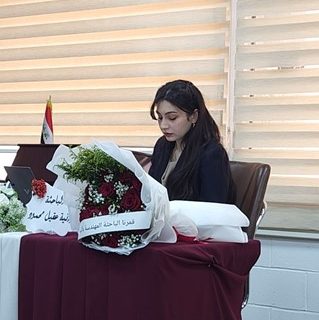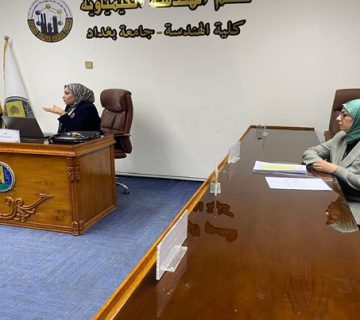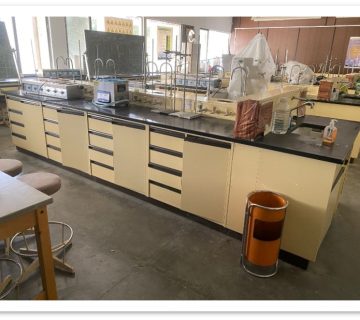The Chemical Engineering Department at the College of Engineering, University of Baghdad, held an PhD thesis examination titled:
“ Improving the Properties of Microfiltration Membranes by Inorganic Additives for Separation of Oil-in-Water Emulsion “
On Thursday 18-7 -2024
By the student Sara Ali Sadek and supervised by Prof. Dr Sama Mohammed Al-Jubouri. The examination committee consisted of Prof. Dr. Tahseen Ali AlHattab as Chairman and the membership of Prof. Dr. Basma Abbas Abdulmajeed, Prof. Dr. Ahmed Faiq Al-Alawy, prof. Dr. Ibtehal K. Shakir and Prof. Dr. Asrar Al Obaidy.
After conducting the public discussion and listening to the student’s defense, the thesis was accepted. The thesis was summarized as follows:
Global awareness has been raised to tackle the impact of produced water effluents from the oil and gas industries on the environment. In this work, embedding of inorganic nanoparticles (NPs) such as eco-friendly silicon dioxide (B-SiO2NPs), commercial silicon dioxide (C-SiO2NPs), stannic oxide (SnO2NPs), and coexisting mixtures of B-SiO2-SnO2@PEG-400 into the polyvinylchloride (PVC) was studied. Twenty-two membranes consisting of a fixed PVC concentration of 15 wt.%, and varying loading of nanoparticles of 0.1, 0.25, 0.5, 1, and 1.5 wt.% were cast. Microfiltration membranes were fabricated via the phase inversion method and their properties and performance were studied using a crossflow configuration with simulated O/W emulsion as a feed. The characterization of the developed membranes was achieved using Fourier-transform infrared spectroscopy, field emission scanning electron microscope, atomic force microscopy, and water contact angle. The results showed that embedding NPs outstandingly reduced the membrane contact angle from 82.3o for the neat PVC membrane to 29.7o, 29.6o, and 30.7o, for the 0.5 wt.% B-SiO2NPs (S3), 1wt.% SnO2NPs (SN4), and 0.5 wt.% B-SiO2-SnO2@PEG-400 (P2) membranes, respectively. The impact of pressure ranges from 1.5 to 3.5 bar, temperature from 25 to 45 oC, and O/W emulsion concentrations from 100 to 1000 mg/L on the membrane flux and removal percent were examined. The maximum rejection of oil achieved by the S3 membrane over 98.15 % of NTU removal%, and up to 99.19 % of COD removal% using 100 mg/L O/W emulsion. The innovative SnO2/PVC membranes showed the COD removal% of 99.6% and NTU removal% of 99.3% using the SN4 membrane, compared to 83.29% and 86.11% using the neat PVC membrane. This was attributed to enhancing the comprehensive porosity, and hydrophilicity of the membranes and improving their grifted negative charge. Embedding of 10 wt.% of PEG-400 with coexisting B-SiO2-SnO2 into PVC matrix increased the casting solution viscosity and membranes porosity. P2 membrane achieved maximum NTU removal% of 99.9% and COD removal% of 99.8%.
The flux recovery ratio (FRR%) was 96.8% for S3 membrane, 94.6% for SN4 membrane, and 97.14% for P2 membrane. The fundamental mechanism involved in the flux drop during crossflow MF was studied using the Hermia blocking models and the modified model by Field. The standard and intermediate pore blocking models provided the best prediction for the experimental behavior when analyzing the flux reduction with time for the S3 membrane and the SN4 membrane. The complete pore blocking followed by cake layer formation were the controlled behavior for the P2 membrane. This research established regression equations of the flux for the membranes in which these equations are highly correlated with R2 of 98.33% for S3 membrane, 99.52% for SN4 membrane, and 97.79% for P2 membrane using the surface response methodology (RSM).








